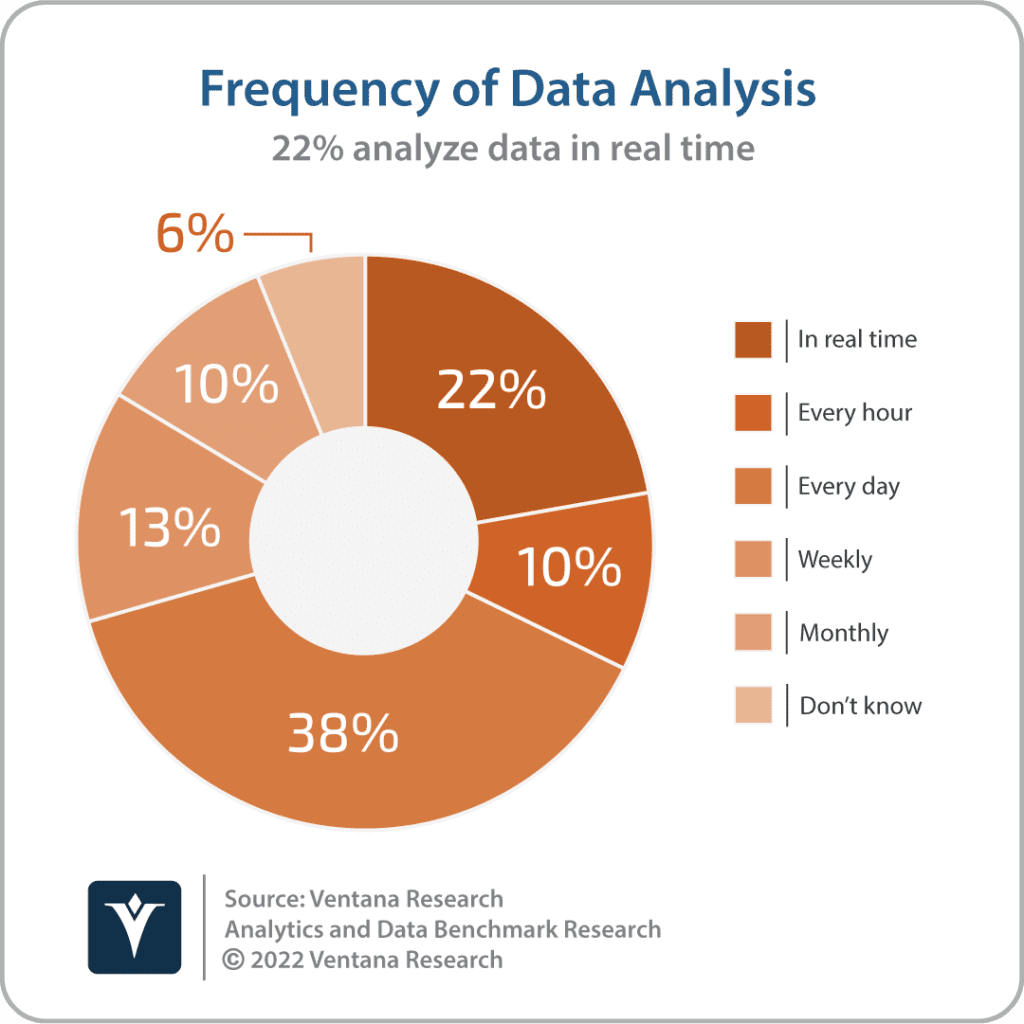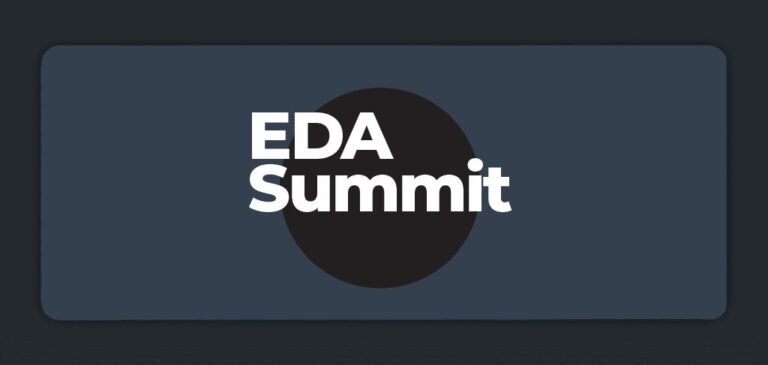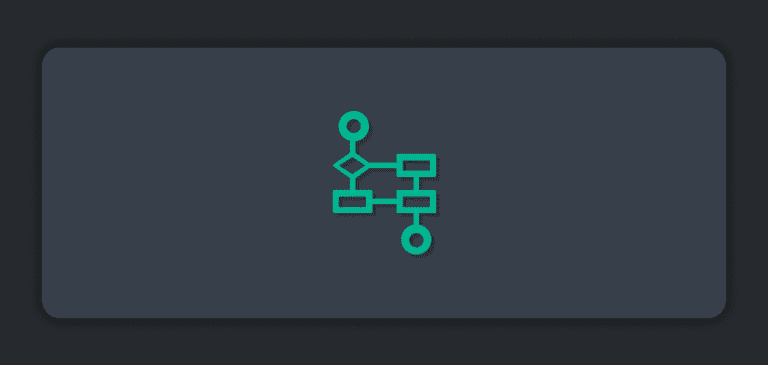EDA Summit recently held the second free educational webinar in their EDA Summit Series called “Data Mesh Meets Event Mesh” featuring Matt Aslett, VP and research director at Ventana Research as well as Jesse Menning, an architect in Solace’s office of the CTO. With this post I’ll summarize what they covered.
What is Data Mesh and What are the Benefits?
Matt Aslett went straight into the definition of a data mesh, as outlined by the idea’s originator Zhamek Dehghani in her forthcoming book: “Data Mesh is a sociotechnical approach to sharing, accessing and managing analytical data in complex and large-scale environments – within or across organizations.”
He then outlined the 4 main principles or defining characteristics of a data mesh:
- Domain-oriented data ownership: Data owners take responsibility and stewardship for the data they make available to share with others.
- Treat data as a product: As a follow on to ownership and stewardship, the data should be treated as a product, and all that implies from a full lifecycle perspective.
- Provide a self-service platform: These data products should be available for consumption by others in a self-service manner.
- Federated governance: As a result of data sharing with distributed ownership, one will need a governance model that allows for some level of autonomy (but not complete autonomy).
Aslett then outlined what he saw as the main benefits of a data mesh, i.e. that it can:
- Empower domain teams by giving them ownership over control of their own data.
- Encourage collaboration amongst all data participants
- Facilitate data aggregation.
- Prevent data silos by dividing up ownership and encouraging sharing.
- Reduce duplication of data and effort, again due to key tenant of sharing.
- Reduce cost of ownership through reduced of effort and duplication.
- Reinforce the use of consistent policies and standards.
Data Mesh Challenges
Aslett then outlined some of the challenges faced when implementing a data mesh, like the need for technological and cultural evolution; data governance; the need to build a tailored solution for your specific needs; and finally, technology investments.As Zhamek Dehghani notes, effective use of data mesh requires potentially significant organizational and cultural change. It can be challenging to move from centralized control to decentralized; from a monolithic to a distributed architecture; from top-down governance to federated governance; and from treating data as an asset to data as a product.
Data mesh also requires very disciplined data governance and continual monitoring and enforcement of data quality service levels. It is important to note that governance is federated, not distributed and ideally should be codified and potentially even automated. Each business domain also needs to take data quality ownership of their own data.
Data mesh adopters may also run into challenges around strict enforcement of interoperability standards, which is required for successful adoption, as well as technology vendors pushing for a specific platform, when, by definition, data mesh is meant to be platform agnostic.
Aslett made it clear in his presentation that there is no quick fix. Data mesh is not an “off the shelf” product, so you should be concerned if any vendor claims they can provide you a complete data mesh.
Considerations for Adopting Data Mesh Architecture
One of the key considerations in adopting a data mesh is how you will provide access to the domain owned data products. There are two main approaches: push and pull.
Consider this example to explain the two approaches: Master customer data might be owned by a single department and changes to customer data can be critical to many other business functions. Ideally, any changes to customer data should be pushed in real-time to reliant consumers via something like an event mesh, but if the data is less critical or timely the data consumers can pull (or query) the data when it needs it.
Frequency of analysis of data is one way organizations should think about this push or pull approach. Ventana’s own research shows that 22% or organizations have a requirement to analyze data in real-time.
Aslett also Dehghani as noting that, “Business facts are best presented as business domain events, and can be stored and served as distributed logs of time-stamped events for any authorized consumer to access.” Aslett believe events and event-driven architecture have significant roles to play in implementing a data mesh.
In closing, Aslett recommended considering both the business benefits and the technology requirements of data mesh and suggests that all organizations should consider the potential advantages in adopting a data mesh approach, but also be aware of the significant organizational and cultural changes that are associated with its adoption.
The Event-Driven Data Mesh
The EDA Summit Series session then turned to Jesse Menning, a senior architect in the office of the CTO at Solace. Menning aimed to explain what capabilities of an event-driven data mesh are mature, emerging, and are on the horizon.
Event-Driven Data Mesh – Mature Capabilities
For mature capabilities, he felt real-time analytics, large-scale data collection, platform agnostic connectivity, and support of open standards are all well-handled today.
- Feeding real-time analytics: There are a few ways to achieve this, either getting data directly from the transactional layer, via change data capture (CDC) as an example, or getting data from the analytical layer. Menning believes feeding data directly from the transactional layer is a mistake, as that data needs to be enriched and contextualized. He suggests using some form of CDC from the analytical layer and sharing that data to consuming applications/domains via an event broker.
- Large-scale data collection: Data mesh architecture can bring a flood of data. Menning explains that with an event-driven approach, you can micro-target your data requests for downstream processes by using advanced topic filtering to stream only the data you need.
- Platform agnostic connectivity: Menning explains that you don’t want each data domain owner to have to figure out how to distribute their data across the enterprise. Instead, you should use a platform agnostic utility to make the data available, no matter where it exists. An event mesh can help with data distribution in this situation.
- Support Interoperability standards: Data consumers shouldn’t be limited in how consumers must receive data from the data mesh. Event brokers today can perform protocol translation between sender and receiver, and support open APIs as well as higher-level standards such as CloudEvents and AsyncAPI.
Event-Driven Data Mesh – Emerging Capabilities
For event-driven data mesh capabilities that are emerging, Menning looked to capabilities that were pioneered in the synchronous data world and should be replicated in the world of asynchronous event-driven interactions.
- Cataloging/discovery/self-service access of data products: The ultimate success of data products is measured by their use throughout the enterprise. Vendors are gradually bringing to market the ability to make event-driven data easily discoverable and easy to catalog in a self-service manner. PubSub+ Event Portal from Solace is an example of this.
- Observability: Menning asserts that if analytical data is meant to be as important as your transactional data, then you need to safeguard it in a similar manner. You must ensure it is tracked and traceable from origin to consumption. Event-driven patterns have long lacked the capabilities of advanced observability, but this is changing with the adoption of standards such as OpenTelemetry.
- Collaborative governance: According to Menning, we are moving from a time of data anarchy to federated governance and mature enterprise data policies – and ideally to an end state where policy can effectively be represented as code. Federated governance requires task-specific tooling, with event catalogs, and standards such as AsyncAPI.
Event-Driven Data Mesh – Future Capabilities
Lastly, Menning covered event-driven data mesh capabilities that he views as “on the horizon”, which he explains go hand-in-hand with data policies and asking oneself the question, “Can we get sued for this?”
Menning explains that if the answer is yes, an enterprise-level data policy is required, which includes features/capabilities like access control, regulations (ie. GDPR), confidentiality (like PII and PHI), redactions, and encryption.
If the answer to the question is no, then the policies can be viewed differently. Examples of capabilities might include mandatory header meta-data (contextualizing the data), observability requirements, topic structures (for routing), and data quality through schema validation and other tools.
Menning asserts that “policy-as-code” is an ideal end state for governance. You want consistent use of policies across domains, and you don’t want them to be bypassed. An emerging open-source standard called Open Policy Agent (OPA) is his recommended approach with its parallels to infrastructure-as-code.
Webinar Survey Results and Q&A
During the webinar event, live attendees completed a survey on their use and adoption of data mesh. The results showed that data mesh is still very much an emerging concept, with only 2% of respondents currently using data mesh in production, vs 17% who have pilot implementations. Half of the respondents (48%) plan to implement data mesh in the next 1-2 years whereas 31% currently have no plans at all.
Explore other posts from category: For Architects

 Roger Sabourin
Roger Sabourin





